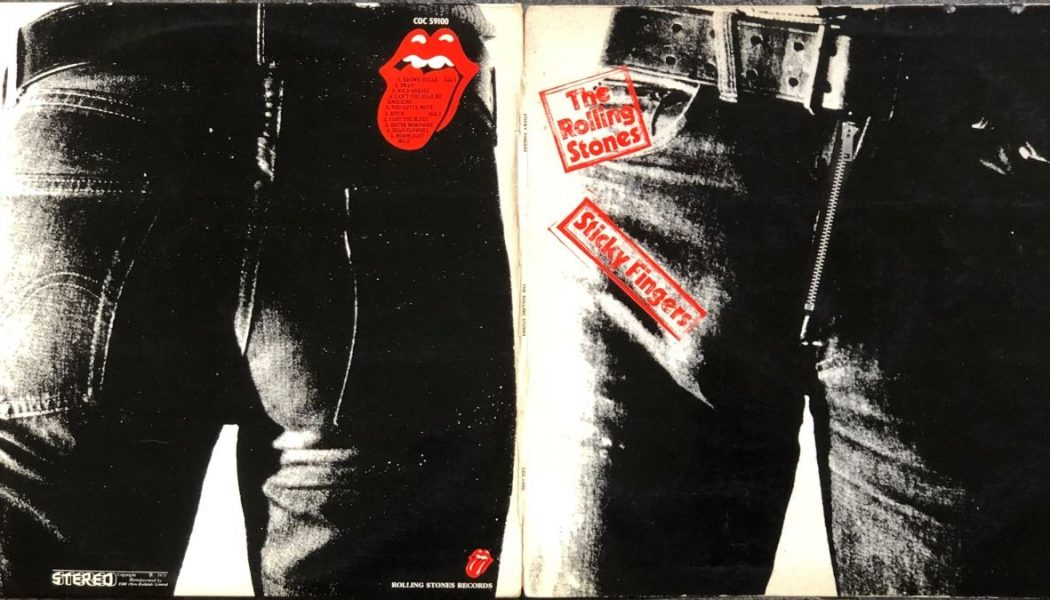“We’re playin’ on a level that most will never see.”
William Forsythe’s Sheriff Wydell says that in the 2005 movie The Devil’s Rejects. It could just as easily be attributed to Keith Richards, circa 1971.
From 1968-1972, The Rolling Stones were on an iconic, career-defining run that arguably surpasses that of any of their British Invasion-era peers and tops any four-album stretch by every other rock band.
But this creative surge came with an encroaching darkness. Co-founder Brian Jones was a creative and personal liability. He was pushed out, then found dead in his swimming pool. Jagger and Richards skipped his funeral.
Related Video
On July 5th, 1969, Mick Taylor made his debut as the group’s new lead guitarist at their first performance in two years, a tribute performance for Jones in London’s Hyde Park. To commemorate his deceased former bandmate, Jagger released white butterflies into the audience. It’s the last peaceful image to be associated with The Rolling Stones for a long time.
By the end of 1969, The Stones were social pariahs. The band’s free concert at Altamont Speedway in California ended with four human deaths (one of them a murder at the hands of a Hell’s Angel) and signified the death of the ‘60s peace-and-love dream. It also transformed the perception of The Rolling Stones from bad boys to something more sinister.
From this tumult, Sticky Fingers was born. It’s the sound of a band withdrawing within itself, channeling the insanity and surrounding negativity into its art. Recorded during and in the aftermath of that ill-fated ’69 tour and their increasing personal excesses, it showcases a band on the run, literally and figuratively.
Soon after its April 1971 release, The Rolling Stones were exiles from England and holed up in a French mansion to avoid drug squads and paying taxes. Exile on Main St. arose from this insanity. But that’s another story altogether.
This is about Sticky Fingers and how it turned The Rolling Stones’ pre-concert introduction as “The Greatest Rock and Roll Band in the World” into a reality.
Sticky Tidbits
<img data-attachment-id="1122128" data-permalink="https://consequence.net/2021/04/gimme-a-reason-the-rolling-stones-sticky-fingers/sticky-fingers-nz-outer/" data-orig-file="https://consequence.net/wp-content/uploads/2021/04/sticky-fingers-nz-outer.jpeg?quality=80" data-orig-size="1200,675" data-comments-opened="1" data-image-meta="{"aperture":"0","credit":"","camera":"","caption":"","created_timestamp":"0","copyright":"","focal_length":"0","iso":"0","shutter_speed":"0","title":"","orientation":"0"}" data-image-title="sticky-fingers-nz-outer" data-image-description="
Sticky Fingers
” data-medium-file=”https://consequence.net/wp-content/uploads/2021/04/sticky-fingers-nz-outer.jpeg?quality=80&w=300″ data-large-file=”https://consequence.net/wp-content/uploads/2021/04/sticky-fingers-nz-outer.jpeg?quality=80&w=1024″ loading=”lazy” class=”aligncenter size-full wp-image-1122128″ src=”https://consequence.net/wp-content/uploads/2021/04/sticky-fingers-nz-outer.jpeg?quality=80&resize=1031%2C580&strip” alt=”Sticky Fingers” width=”100%” srcset=”https://consequence.net/wp-content/uploads/2021/04/sticky-fingers-nz-outer.jpeg 1200w, https://consequence.net/wp-content/uploads/2021/04/sticky-fingers-nz-outer.jpeg?resize=150,84 150w, https://consequence.net/wp-content/uploads/2021/04/sticky-fingers-nz-outer.jpeg?resize=300,169 300w, https://consequence.net/wp-content/uploads/2021/04/sticky-fingers-nz-outer.jpeg?resize=768,432 768w, https://consequence.net/wp-content/uploads/2021/04/sticky-fingers-nz-outer.jpeg?resize=1024,576 1024w, https://consequence.net/wp-content/uploads/2021/04/sticky-fingers-nz-outer.jpeg?resize=1031,580 1031w, https://consequence.net/wp-content/uploads/2021/04/sticky-fingers-nz-outer.jpeg?resize=590,332 590w, https://consequence.net/wp-content/uploads/2021/04/sticky-fingers-nz-outer.jpeg?resize=278,156 278w, https://consequence.net/wp-content/uploads/2021/04/sticky-fingers-nz-outer.jpeg?resize=173,97 173w, https://consequence.net/wp-content/uploads/2021/04/sticky-fingers-nz-outer.jpeg?resize=198,111 198w, https://consequence.net/wp-content/uploads/2021/04/sticky-fingers-nz-outer.jpeg?resize=140,79 140w, https://consequence.net/wp-content/uploads/2021/04/sticky-fingers-nz-outer.jpeg?resize=674,378 674w” sizes=”(max-width: 1024px) 100vw, 1024px”>
01. Sticky Fingers holds a special spot in The Rolling Stones’ discography as the first record to top both the US and UK charts.
02. You know the iconic lips-and-tongue logo The Rolling Stones use? Well, it makes its debut appearance on the packaging to Sticky Fingers.
03. Speaking of the packaging, the original vinyl sleeve is a work of art. Designed by Andy Warhol and his Factory, the original release had an actual working zipper on the front that opened to reveal a pair of white briefs and a male model’s crotch. If you have a copy with the real zipper, you’re in luck; subsequent pressings eliminated it due to complaints that it warped the record.
“Brown Sugar”
04. The opening chords are some of the most recognizable in classic rock history. Oddly enough, Keith Richards didn’t come up with it. No, the Human Riff was outdone by Mick Jagger, who conjured up the iconic guitar lick and masterminded the entire song.
05. After making his first appearance on “Live with Me” a couple years prior, saxophonist Bobby Keys makes his presence with the band felt on “Brown Sugar”. His sax solo is indispensable and nearly as memorable as that aforementioned opening riff.
06. Jagger’s lyrics are absolutely wild. You’ve got the slave trade, rape, consensual sex (including the then-taboo topic of interracial sex), sadomasochism, and lots of drugs. A brilliant scene in The Wire breaks it down wonderfully. There’s no way a band could get a song with this type of content on the radio today, much less have it be considered one of the greatest singles in the history of popular music.
07. If you’ve ever wondered how this song would sound with Eric Clapton on lead guitar, you’re in luck; the 2015 reissue of Sticky Fingers includes a take recorded at Keith Richards’ birthday party in 1970. “Slowhand” offers up some particularly vicious slide work, making the song more overtly bluesy than the soul-rock of the official LP take.
“Sway”
08. “Brown Sugar” presents the archetype of The Stones in popular music and culture, but “Sway” is a glimpse of the band as-they-were in 1971. Everything about this song speaks to the strung-out, increasingly weary state of the band at this time. First, just check out that riff. Whereas there’s an ebullience to “Brown Sugar”, “Sway” is dark and heavy, easily the heaviest-sounding track in The Stones’ oeuvre.
09. Jagger has never really been one to wax autobiographical. Only “Jigsaw Puzzle” off Beggars Banquet, with its detailed descriptions of each individual member of the group, and the “I hope we aren’t too messianic or a trifle too satanic” line in “Monkey Man” really spring to mind. On “Sway”, his rock star fatigue practically bursts out the speakers. There’s his troubled, world-weary delivery. He sounds like a person at the end of his emotional tether. And there’s the actual words, which reflect his bitterness and encroaching ennui. From the opening lines of “Did you ever wake up to find/ A day that broke your mind?” to the Brian Jones-referencing “Ain’t flinging tears on the dusty ground/ For my friends on the burial ground” and a chorus of “It’s just that demon life has got you in its sway,” it’s clear that it may only be rock ‘n’ roll, but Jagger isn’t liking it much at all.
10. Mick Taylor’s 1969-1975 tenure was the high point of The Rolling Stones, for sheer musical chops alone. “Sway” is his triumph. Richards is officially credited as a co-writer and guitarist on the track, but was nowhere to be found when it was recorded at Jagger’s Stargroves mansion. Instead, it was Jagger and Taylor, the two Micks, providing the guitar. Jagger was still a rudimentary guitarist at the time, so the burden fell upon Taylor and he delivers. Take a listen to his solo on the outro; it’s remarkable.
11. On the topic of that outro, take a real good listen. While Taylor ascends to the stratosphere with his incendiary lead, the rest of the band is wallowing in the murk. Nicky Hopkins provides a sturdy rhythmic anchor on the piano, then Paul Buckmaster (most known for his work with Elton Joh) comes in with a string arrangement that heightens the dramatic stakes and brings the song to its conclusion.
12. Misery loves company: Pete Townshend knows a little bit about resenting rock superstardom. In 1970-71, he was laboring over his Lifehouse project, an album and film even more grandiose than Tommy, drinking heavily and generally having a miserable go of things. He, along with hard-partying Ronnie Lane of the Faces, joins Keith Richards in providing the back-up vocals on the chorus.
“Wild Horses”
13. Much has been made of the Jagger/Richards dynamic and its highs and lows. “Wild Horses” is a textbook example of what happens when the Glimmer Twins are working in perfect sync. Regretting having to go on tour without him, Richards conjured up the melody, opening lines, and the chorus as a lullaby for his son Marlon. Jagger fleshed out the rest, with verses that may have been about the overdose of and break-up with then-girlfriend Marianne Faithfull. He’s always denied that it’s about her, claiming that the words were an expression of the general melancholy he felt at the time.
14. Jagger is probably the greatest frontman of all time. He’s a showman, the archetype for countless singers over the past 60 years. But he’s also one of the most dynamic vocalists and interpreters in pop history, and “Wild Horses” highlights his growth as a singer. On early tracks like “As Tears Go By”, he lacked the maturity and gravitas necessary for the material. But he nails “Wild Horses”. His voice is full of mourning and regret over a relationship that’s gone awry and a past that’s gone forever.
15. The sorrow Jagger expresses is accentuated by some exquisite lead guitar work from Richards. On a record that serves as an electrifying coming-out party for Mick Taylor, the subtle, heartfelt country-blues solo is a nice reminder of what Keef brought to the table as a musician.
16. Rolling Stones keyboard player (and band co-founder) Ian Stewart refused to play on “Wild Horses”, expressing his distaste for its minor chord structure. The band recruited Memphis session player Jim Dickinson, whose credits include Aretha Franklin and Big Star, to provide accompaniment on the tack piano.
17. Urban legend says that alt-country godfather Gram Parsons actually wrote “Wild Horses” and The Stones nicked it. The fact his rendition was actually released before the Stones’ take has only fueled this rumor. Regardless, the track and its blend of country-blues and pop hooks is one of the foundational pieces of the alt-country genre.
“Can’t You Hear Me Knocking”
18. In the 1960s, much of the “experimental” work of The Rolling Stones felt forced and/or just wasn’t very good (I’m looking at you, Their Satanic Majesties Request). But on “Can’t You Hear Me Knocking”, the band lurches into accidental brilliance. The jam that marks the back half of the track was unplanned; instead of putting down his guitar when the outro was slated to fade out, Taylor just continued to noodle. Everyone else jumped back in and followed his lead. When they played it back later, the song proper and the jam, The Stones decided the entire piece was a keeper.
19. The relationship and interplay between Keith Richards and drummer Charlie Watts is at the core of The Stones’ musical dynamic. On “Can’t You Hear Me Knocking”, Richards comes in hot with that tasty riff, and Watts follows his lead. The pair lock into the rhythmic groove that carries the first two minutes of the song.
20. Jagger is a master of blurring the lines of sex, drugs, and violence in his lyrics, with “Let it Bleed”, “Midnight Rambler”, and “Brown Sugar” immediately springing to mind. “Can’t You Hear Me Knocking” is another song in that vein. It’s ambiguous; whose door is Jagger kicking down? Who is he stalking? A drug dealer? A strung-out paramour? Both?
21. “You got cocaine eyes/ You got speed-freak jive” is one of the coolest and most evocative passages Jagger’s ever ginned up. It’s written and sung with the wickedness of someone well-acquainted with pupil-dilated, coked-out psychobabble.
22. The jam is noteworthy for a few reasons. First, Bobby Keys’ sax playing. He guides the first portion of the journey. And you’ve got the return of Rocky Dijon. The Ghanaian-born percussionist is an unsung hero in this era of The Stones. He played the congas on “Sympathy for the Devil” and “Can’t Always Get What You Want”. This song oft receives comparisons to early Santana; his playing is a big reason for that.
23. The most underrated part of the closing section is bassist Bill Wyman’s role in the affair. He provides the understated, funky rhythm to keep the song humming along, as well as a sturdy anchor for Keys and Taylor to solo over.
“You Gotta Move”
24. Richards once said of peers like Eric Clapton (and his own bandmate Taylor), “They can play as many notes under the sun, but they just can’t hold that rhythm down, baby.” The cover of Mississippi Fred McDowell’s standard “You Gotta Move” has nothing to do with crunchy riffs or big solos; it’s straight, unadorned Delta blues.
25. Over the years, Jagger has put on some ridiculous vocal affectations, from the hyperbolic country drawl on “Faraway Eyes” to the we-care-a-lot condescension of “Salt of the Earth”. On “You Gotta Move”, he goes for a Southern American accent and does it without a single trace of camp. It shouldn’t work, but it does and serves as an homage to the track’s Southern gospel origins.
26. Taylor plays the electric slide, and its his most subtle performance on the entire record. The slide work underscores the emotional potency of the Jagger/Richards vocal track and shows just how versatile he is as a guitarist.
27. Just as they do on Robert Johnson’s “Love in Vain”, The Stones reveal that as purveyors and interpreters of the blues, they’re at the top of the classic rock heap. It could have gone the other way. Case in point: on the unfortunately named Honkin’ on Bobo, the Stones-indebted Aerosmith cover “You Gotta Move”. Instead of showing even a base level of understanding of the original material or a modicum of the emotion that goes into the blues at its finest, they offer up a giant slap of arena butt-rock at its shittiest.
“Bitch”
28. “Bitch” shows that while Jagger and Richards hog most of the spotlight, it’s Charlie Watts that gives The Rolling Stones their motor. He’s a monster, just jackhammering out the propulsive beat that drives the song. That fill he plays when Jagger’s “heart beats louder than a big bass drum” is utterly sublime.
29. Richards has repeatedly stated that his teaming with Ron Wood, where they each share lead and rhythm duties is what works best for the band. With all due respect, Richards is wrong, and “Bitch” highlights why. Richards plays that red-hot riff, imbuing the track with the requisite amount of sleaze. This frees up Taylor to just cut loose and start soloing like a madman at the 2:30 mark or so. Being relegated to primarily rhythm guitarist may not have been what Richards wanted, but it’s certainly what The Stones needed.
30. If “Wild Horses” is Jagger at his most heartfelt, “Bitch” is him at his most cutting. He snarls, “It must be love, it’s a bitch.” Contrary to the implication of the title, he’s not referring to a woman but the entire concept of romantic entanglements as a “bitch.” The sentiment tracks, given his well-documented love life.
31. The 1971-72 era of The Stones was the first to feature a horn section. “Bitch” marks its first fully fleshed-out appearance on a studio album. Bobby Keys is joined by trumpeter Jim Price and the duo team with Richards, Watts, and Wyman to give the track its greasy, Stax-style sound.
“I Got the Blues”
32. Speaking of Stax, “I Got the Blues” reflects how strongly influenced The Stones are by the big ballads of Otis Redding. Jagger does his finest interpretation of the lovelorn soul man, belting out his misery.
33. “I Got the Blues” is sequenced perfectly on the record. Coming right after “Bitch” and its venomous take on relationships, “Blues” offers a melancholic, tender look at the same subject. Its vulnerability provides a stark contrast to the misogyny in some of The Stones’ earlier (“Under My Thumb”) and later (“Some Girls”) material.
34. Obviously, one of the major factors in this song’s effectiveness is the use of the horn section. But what really makes this tune special is the organ. That comes courtesy of Billy Preston, fresh off working with The Beatles on Let It Be. The collaboration between Preston and The Stones would continue on and off throughout the ‘70s, culminating in his serving as the band’s keyboard player on their 1977 tour.
“Sister Morphine”
35. Aside from covers, nearly every Rolling Stones song is credited to Jagger/Richards, even if others helped to craft it. (Taylor is still pissed he’s not credited for “Sway”.) This makes “Sister Morphine” unique, as it’s attributed to Jagger/Richards and Marianne Faithfull.
36. Faithfull originally recorded the song in 1969, and her version wrestles with her serious drug addiction at the time. She’s accompanied by Jagger on acoustic, Watts on drums, accomplished session man Jack Nitzsche on piano, and Ry Cooder handles the slide guitar.
37. In the aftermath of Faithfull’s break-up with Jagger, suicide attempt, and ongoing substance abuse issues, Jagger kept mum about how it impacted him. But his emotions are palpable throughout The Stones’ rendition of “Sister Morphine”. He sounds alternately beleaguered and agonized, resigned to the thralls of addiction.
38. While the arrangement on Sticky Fingers is largely the same, Faithfull’s is a little more elegant, a little more restrained. The Stones imbue the song with an anxious tension that more closely reflects the madness going on around them.
39. Taylor doesn’t appear on this track. It’s essentially the same musicians from the Faithfull track playing on this one. It’s Cooder playing the slide and it’s his contribution that dominates the performance. His slide work is impeccable and serves to heighten the emotional tenor of the song.
40. More praise for Watts here. He’s just such a pro. His fills at 2:37, 3:45, and 4:33 act as the commencement point for each movement of “Sister Morphine”, guiding it from the slow, acoustic country start to the dramatic middle section and the tumultuous outro where he and Cooder are in perfect sync with each other.
“Dead Flowers”
41. Musically speaking, this is relatively straightforward country-rocker and the by-product of the friendship between Richards and Gram Parsons.
42. Jagger has mentioned that country songs aren’t necessarily his strong suit as a vocalist, hence his tendency to ham it up a bit. But this time, his irony-laden delivery matches the darkly sardonic subject matter of “Dead Flowers”, a song that’s both a fuck you to an upwardly mobile old flame and an expression of a day in the life of a heroin addict.
43. The vocals on the chorus are what sells this song and pulls its various themes together. Jagger’s exaggerated, almost tongue-in-cheek, affectation is responsible for the glib kiss-off. Richards goes all-out with his earnest, high-pitched harmonies, ensuring that the song is grounded in the country music tradition and not a mockery of it.
44. Sticky Fingers is full of passages where Jagger uses juxtaposition as a lyrical technique. The entirety of “Dead Flowers” is a series of them, but the second verse is the most luridly evocative: “When you’re sitting back, in your rose pink Cadillac/ Making bets on Kentucky Derby Day/ I’ll be in my basement room, with a needle and a spoon/ And another girl to take my pain away.”
45. As a verse, that’s pretty tough to top. Instead of even attempting it, they wisely kick it over to Taylor for a spot-on, fluid slide guitar solo to bring it on home.
46. It’s a little thing, but that little tinkling that Ian Stewart does on the piano in the last couple seconds is kind of hilarious and accentuates the looseness of the music itself.
“Moonlight Mile”
47. It’s hard to think that any Rolling Stones song, much less something off one of its most celebrated albums, could be underappreciated. But “Moonlight Mile” fits that description.
48. Richards went AWOL and skipped playing on “Moonlight Mile”. That’s a bummer, as it’s one of the most ambitious recordings they’ve made. Paul Buckmaster’s string arrangements are majestic and align with Taylor’s riff. Watts’ drums sound huge and they combine to create true beauty.
49. When strings and Watts work in tandem, swelling to a crescendo that’s capped at the 4:08 mark by an anguished Jagger shouting, “’Cause I’m just about a moonlight mile on down the road,” it’s gut-wrenching and one of the most perfect sequences ever laid down.
50. “Moonlight Mile” is a fascinating insight into Jagger’s psyche. The Stones were in the middle of the legendary run that would define their career (or at least their career before becoming a stadium-rock capitalist enterprise around Steel Wheels). But he wasn’t feeling like an artist on a creative high; Jagger was lonely and growing disenchanted with the rock ‘n’ roll life. The fact that he was finding it so hard to sustain in 1971 makes his continued excellence as a performer, as well as The Rolling Stones’ ongoing existence, all the more remarkable.










